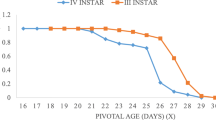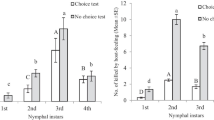Abstract
Control of the sugarcane borers, Diatraea saccharalis and Diatraea impersonatella (= D. flavipennella) (Lepidoptera: Crambidae), in Brazil, is based on mass release of the larval parasitoid Cotesia flavipes (Hymenoptera: Braconidae). However, this method does not prevent some pupae of these borers from completing development and recolonizing the crop. Thus, additional control is required. This study investigated the parasitoid Tetrastichus howardi (Hymenoptera: Eulophidae) to control pupae of sugarcane borers, especially D. impersonatella. Regardless of larval instar and species, no larval parasitism occurred within 24 h of exposure. Nevertheless, a longer exposure period (ca. 96 h) resulted in parasitism of older larvae. Approximately 90% of pupae of both borers were parasitized by T. howardi within 24 h of exposure, and the parasitoid produced a similar number of offspring with >90% females. The developmental time of T. howardi parasitizing D. impersonatella pupae was delayed ~2 days from that of in D. saccharalis. No-choice trails revealed that parasitoid females took longer to start probing larvae compared to pupae. Likewise, when larvae and pupae were offered simultaneously (choice test), the latter represented the first choice of about 92% T. howardi females. The elapsed time to first attack was less on pupae than on larvae, whereas the number of attacks and probing time was greater on pupae. In addition, parasitism on D. impersonatella pupae was higher than on larvae feeding on artificially infested sugarcane seedlings. These results suggest that T. howardi prefers to parasitize the pupal stage and has the potential to be used as a biological control agent to complement the control of sugarcane bores.

Similar content being viewed by others
References
Al-Wahaibi AK, Walker GP (2000) Oviposition behavior of Anagrus nigriventris, an egg parasitoid of beet leafhopper, Circulifer tenellus. Biol Control 45:139–153
Araújo JR, Botelho PSM, Araújo SMSS, Almeida LC, Degaspari N (1985) Nova dieta artificial para criação da Diatraea saccharalis (Fabr.). Saccharum APC. Rev Tecnol Indúst Açuc Alcool 36:45–48
Barbosa RH, Kassab SO, Pereira FF, Rossoni C, Costa DP, Berndt MA (2015) Parasitism and biological aspects of Tetrastichus howardi (Hymenoptera: Eulophidae) on Erinnyis ello (Lepidoptera: Sphingidae) pupae. Cienc Rural 45:185–188
Barbosa RH, Pereira FF, Motomiya AVA, Kassab SO, Rossoni C, Torres JB, Mussury RM, Pastori PL (2019) Tetrastichus howardi density and dispersal toward augmentation biological control of sugarcane borer. Neotrop Entomol 48:323–331
Cheavegatti-Gianotto A, Abreu HMC, Arruda P, Filho JCB, Burnquist WL, Creste S, Ciero L, Ferro JA, Figueira AVO, Filgueiras TS, Grossi-de-Sá MF, Guzzo EC, Hoffmann HP, Landell MGA, Macedo N, Matsuoka S, Reinach FC, Romano E, Silva WJ, Filho MCS, Ulian EC (2011) Sugarcane (Saccharum X officinarum): a reference study for the regulation of genetically modified cultivars in Brazil. Trop Plant Biol 4:62–89
Costa DP, Pereira FF, Kassab SO, Rossoni C, Pastori PL, Zanuncio JC (2014) Tetrastichus howardi (Hymenoptera: Eulophidae) in different densities and periods of parasitism on Diatraea saccharalis (Lepidoptera: Crambidae) caterpillars. Ann Entomol Soc Am 107:961–966
Cruz I, Redoan AC, Silva RB, Figueiredo MLC, Penteado-Dias AM (2011) New record of Tetrastichus howardi (Olliff) as a parasitoid of Diatraea saccharalis (Fabr.) on maize. Sci Agric 68:252–254
Favero K, Pereira FF, Torres JB, Oliveira HN, Kassab SO, Zanuncio JC (2015) Reproduction of Tetrastichus howardi (Hymenoptera: Eulophidae) in Diatraea saccharalis (Lepidoptera: Crambidae) pupae at different temperatures. Fla Entomol 98:865–869
Favoreto AL, Pavani RF, Ribeiro MF, Zanuncio AJV, Soares MA, Zanuncio JC, Wilcken CF (2020) Tetrastichus howardi (Hymenoptera: Eulophidae): first report of parasitism in Oxydia vesulia (Lepidoptera: Geometridae). Braz J Biol 1:1–5
Francischini FJB, Campos JB, Alves-Pereira A, Viana JPG, Grinter CC, Clough SJ, Zucchi MI (2017) Morphological and molecular characterization of Brazilian populations of Diatraea saccharalis (Fabricius, 1794) (Lepidoptera: Crambidae) and the evolutionary relationship among species of Diatraea Guilding. PLoS One 12(11):e0186266
Freitas MRT, Fonseca APP, Silva EL, Mendonça AL, Silva CE, Mendonça AL, Nascimento RR, Sant’ana AEG (2006) The predominance of Diatraea flavipennella (Lepidoptera: Crambidae) in sugar cane fields in the state of Alagoas, Brazil. Fla Entomol 89:539–540
Freitas MRT, Silva EL, Mendonça AL, Silva CE, Fonseca APP, Mendonça AL, Santos JS, Nascimento RR, Sant’ana AEG (2007) The biology of Diatraea flavipennella (Lepidoptera: Crambidae) reared under laboratory conditions. Fla Entomol 90:309–313
Garcia JF (2013) Manual de identificação de pragas da cana. FMC, Campinas
Gómez LA, Quintero EM, Jurado JA, Obando V, Larrahondo JE, González A (2009) Una version actualizada de las pérdidas que causan los barrenadores de la caña de azúcar en el valle del río Cauca. In: Memoirs of the Congeso de la Asociación de Técnicos de la Caña de Azúcar, VIII edn. Tecnicaña, Cali, Colombia, pp. 136–143
González JFA, Montes De Oca FN, Ravelo HG (2003) Bio-ecological studies of Tetrastichus howardi Olliff. (Hymenoptera: Eulophidae), pupal parasite of Diatraea saccharalis (Fabr) (Lepidoptera: Crambidae) in Cuba. Centro Agrícola 30:37–41
van Griethuijsen LI, Banks KM, Trimmer BA (2013) Spatial accuracy of a rapid defense behavior in caterpillars. J Exp Biol 216:379–387
Hensley SD, Hammond AM Jr (1968) Laboratory technique for rearing the sugarcane borer on an artificial diet. J Econ Entomol 61:1742–1743
Keinan Y, Kishinevsky M, Segoli M, Keasar T (2012) Repeated probing of hosts: an important component of superparasitism. Behav Ecol 23:1263–1268
Khafagi WE, Hegazi EM (2008) Does superparasitism improve host suitability for parasitoid development? A case study in the Microplitis rufiventris-Spodoptera littoralis system. Biol Control 53:427–438
La Salle J, Polaszek A (2007) Afrotropical species of the Tetrastichus howardi species group (Hymenoptera: Eulophidae). African Entomol 15:45–56
Mesquita FLT, Mendonça AL, Silva CE, Correia AMO, Sales DFM, Cabral-Junior CR, Nascimento RR (2011) Influence of Saccharum officinarum (Poales: Poaceae) variety on the reproductive behavior of Diatraea flavipennella (Lepidoptera: Crambidae) and on the attraction of the parasitoid Cotesia flavipes (Hymenoptera: Braconidae). Fla Entomol 94:420–427
Moore SD, Kfir R (1995) Host preference of the facultative hyperparasitoid Tetrastichus howardi (Hymenoptera: Eulophidae). Entomophaga 40:69–76
Obonyo M, Schulthess F, Ru BL, van den Berg J, Silvain JF, Calatayud PA (2010) Importance of contact chemical cues in host recognition and acceptance by the braconid larval endoparasitoids Cotesia sesamiae and Cotesia flavipes. Biol Control 54:270–275
Parra JRP (2014) Biological control in Brazil: an overview. Sci Agric 71:345–355
Passos EM, Wanderley-Teixeira V, Marques EJ, Teixeira AAC, Brayner FA (2014) Cotesia flavipes (Hymenoptera: Braconidae) supresses immune responses in Diatraea flavipennella (Lepidoptera: Crambidae). An Acad Bras Ciênc 86:2013–2024
Pereira FF, Kassab SO, Calado VRF, Vargas EL, Oliveira HN, Zanuncio JC (2015) Parasitism and emergence of Tetrastichus howardi (Hymenoptera: Eulophidae) on Diatraea saccharalis (Lepidoptera: Crambidae) larvae, pupae and adults. Fla Entomol 98:377–380
Pereira K, Guedes NMP, Serrão J, Zanuncio JC, Guedes RNC (2017) Superparasitism, imune response and optimum progeny yield in the gregarious parasitoid Palmistichus elaeisis. Pest Manag Sci 73:1101–1109
Piñeyro NG, Pereira FF, Borges FLG, Rossoni C, Silva AS, Kassab SO (2016) Does multiplying Tetrastichus howardi (Hymenoptera: Eulophidae) in the silkworm affect its biology? Acta Biol Colomb 21:189–193
Rahman M (1970) Mutilation of the imported cabbageworm by the parasite Apanteles rubecula. J Econ Entomol 63:1114–1116
Ruschioni S, van Loon JJA, Smid HM, van Lenteren JC (2015) Insects can count: sensory basis of host discrimination in parasitoid wasps revealed. PLoS One 10(10):e0138045
SAS Institute (2001) SAS/STAT User’s guide, version 8.02, TS level 2MO. SAS Institute Inc, Cary
Shah ZA (2012) Morphology, ultrastructure, and probable functions of the sense organs on the ovipositor stylets of the hymenopteran parasitoid, Venturia canescens (Gravenhorst). Microsc Res Techniq 75:876–883
Silva CCM, Marques EJ, Oliveira JV, Valente ECN (2012) Preference of the parasitoid Cotesia flavipes (cam.) (Hymenoptera: Braconidae) for Diatraea (Lepidoptera: Crambidae). Acta Sci Agron 34:23–27
Silva-Torres CSA, Ramos Filho IT, Torres JB, Barros R (2009) Superparasitism and host size effects in Oomyzus sokolowskii, a parasitoid of diamondback moth. Entomol Exp Appl 133:65–73
Silva-Torres CSA, Pontes IVAF, Torres JB, Barros R (2010) New records of natural enemies of Plutella xylostella (L.) (Lepidoptera: Plutellidae) in Pernambuco, Brazil. Neotrop Entomol 39:835–838
Simonato J, Oliveira HN, Grigolli JFJ, Grigolli MMK, Silva IF (2020) Potential of the parasitoid Tetrastichus howardi (Olliff, 1893) (Hymenoptera: Eulophidae) on the control of Helicoverpa armígera (Hübner, 1805) (Lepidoptera: Noctuidae). J Agric Sci 12:146–154
Smilanich AM, Dyer LA, Gentry GL (2009) The insect imune response and other putative defenses as effective predictors of parasitismo. Ecology 90:1434–1440
Solis MA, Metz MA (2016) An illustrated guide to the identification of the known species of Diatraea guilding (Lepidoptera: Crambidae: Crambinae) based on genitalia. ZooKeys 565:73–121
Takasu K, Overholt WA (1997) Aggressive behaviour of Chilo partellus (Swinhoe) larvae against the parasitoid, Cotesia flavipes Cameron. Insect Sci Applic 17:131–135
Tena A, Kapranas A, Garcia-Mari F, Luck RF (2008) Host discrimination, superparasitism and infanticide by a gregarious endoparasitoid. Anim Behav 76:789–799
Tiago EF, Pereira FF, Kassab SO, Barbosa RH, Cardoso CRG, Sanomia WY, Pereira HC, Silva RMMF, Zanuncio JC (2019) Biological quality of Tetrastichus howardi (Hymenoptera: Eulophidae) reared with Tenebrio molitor (Coleoptera: Tenebrionidae) pupae after cold storage. Fla Entomol 102:571–576
Trevisan M, Bortoli SA, Vacari AM, Laurentis VL, Ramalho DG (2016) Quality of the exotic parasitoid Cotesia flavipes (Hymenoptera: Braconidae) does not show deleterious effects after inbreeding for 10 generations. PLoS One 11:e0160898
Vargas EL, Pereira FF, Tavares MT, Pastori PL (2011) Record of Tetrastichus howardi (Hymenoptera: Eulophidae) parasitizing Diatraea sp. (Lepidoptera: Crambidae) in sugarcane crop in Brazil. Entomotropica 26:143–146
Vargas G, Gómez LA, Michaud JP (2015) Sugarcane stem borers of the Colombian Cauca River valley: current pest status, biology, and control. Fla Entomol 98:728–735
Vinson SB, Iwantsch GF (1980) Host regulation by insect parasitoids. Q Rev Biol 55:143–165
White WH, Viator RP, Dufrene EO, Dalley CD, Richard EP Jr, Tew TL (2008) Re-evaluation of sugarcane borer (Lepidoptera: Crambidae) bioeconomics in Luisiana. Crop Prot 27:1256–1261
Xiaoyi W, Zhongqi Y (2008) Behavioral mechanisms of parasitic wasps for searching concealed insect hosts. Acta Ecol Sin 28:1257–1269
Zamperlini B, Zanuncio JC, Leite JEM, Bragança MAL (1992) Influência da alimentação de Tenebrio molitor L. 1758 (Coleoptera: Tenebrionidae) no desenvolvimento ninfal de Podisus connexivus Bergroth, 1891 (Hemiptera: Pentatomidae). Rev Árv 16:224–2030
Acknowledgments
The provision of stock colonies of D. saccharalis by Roberto (“Sugarcane Growers Association from Paraiba State: ASPLAN”) was greatly appreciated, and we are grateful to Eng. Sandro (“Olho Dágua Sugarcane Mill, Camutanga, PE”) for allowing D. impersonatella collections.
Availability of Data and Material
Analyses reported in this article can be reproduced using the data provided by Rodrigues et al. (2020).
Code Availability
Not applicable.
Funding
The ‘Coordenação de Aperfeiçoamento de Pessoal de Nível Superior’ (CAPES) Foundation with Program PROCAD and the National Council of Scientific and Technological Development (CNPq) with research grants to FFP, CSAST, and JBT.
Author information
Authors and Affiliations
Contributions
Augusto Rodrigues: Conceptualization, investigation, writing. Fabrício F. Pereira: Conceptualization, writing. Paulo R.R. Barbosa: Investigation, formal analysis, writing. Christian S.A. Silva-Torres: Conceptualization, methodology, writing. Jorge B. Torres: Conceptualization, methodology, review and editing, funding acquisition.
Corresponding author
Ethics declarations
Ethics Approval
All applicable international, national, and institutional guidelines for the care and use of animals were considered in the present investigation.
Consent for Publication
All the authors of this manuscript accepted that the paper is submitted for publication in the Journal of Insect Behavior, and report that this paper has not been published or accepted for publication in another journal, and it is not under consideration at another journal.
Conflict of Interest
The authors have no conflict of interest to declare that are relevant to the content of this article.
Additional information
Publisher’s note
Springer Nature remains neutral with regard to jurisdictional claims in published maps and institutional affiliations.
Rights and permissions
About this article
Cite this article
Rodrigues, A., Pereira, F.F., Barbosa, P.R. et al. Parasitism Behavior of Tetrastichus howardi (Hymenoptera: Eulophidae) on Larvae and Pupae of Sugarcane Borers. J Insect Behav 34, 71–81 (2021). https://doi.org/10.1007/s10905-021-09770-4
Received:
Revised:
Accepted:
Published:
Issue Date:
DOI: https://doi.org/10.1007/s10905-021-09770-4




